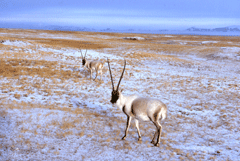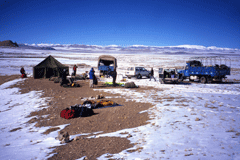
The Tibetan antelope or chiru. (Photo: George Schaller/Wildlife Conservation Society)
The Tibetan antelope or chiru. (Photo: George Schaller/Wildlife Conservation Society)
The Chiru, or Tibetan Antelope, once roamed the Tibetan highlands in herds of a million or more. But poaching and livestock farming diminished their numbers. Wildlife biologist and adventurer George Schaller recently traveled to China’s Chang Tang region to search for Chiru and he was happy with what he found.
GELLERMAN: The Chang Tang is a rolling upland that stretches across the northern part of the Tibetan Plateau in China. It’s one of the least-known places on earth, a sweeping wilderness 16,000 feet high, punctuated with glacial peaks. Field biologist, George Schaller, has been studying this region for more than 20 years.
You might be familiar with his world-famous research on Mountain Gorillas of Central Africa, the lions of the Serengeti, the snow leopards of Nepal, and the pandas of Wolong, China. Now 73, the intrepid Dr. Schaller’s most recent expedition took him to the Chang Tang again, this time in search of another creature, the Tibetan Antelope, or Chiru.

The Tibetan antelope or chiru. (Photo: George Schaller/Wildlife Conservation Society)
But Chiru have one disadvantage: they have the finest wool in the world. During the late 1980s and 1990s they were mass-slaughtered by poachers who sold the wool to India to make shahtoosh shawls for the world’s luxury market. Fortunately this illegal trade has now been much reduced. Indeed in some areas, Chiru seem to be on the increase again.

A typical field camp during the traverse. (Photo: George Schaller/Wildlife Conservation Society)
This winter our team of fourteen Tibetan and Han Chinese and I made a great traverse of the region. We drove a thousand miles cross-country without seeing another person. It was cold, getting down to 25 below zero at night, and a fierce wind often swept over the landscape. But in this seemingly barren country we were surprised by how much wildlife we encountered and were delighted to count about 8,000 Chiru. It was a hopeful sign for the future. We also saw a thousand wild yaks, an animal much more rare than a Chiru. We recorded 22 wolves, several had probably never seen a person before. They showed little fear, and one even visited camp.

Dr. George Schaller. (Photo: Wildlife Conservation Society)

A few members of the field team looking for wildlife. (Photo: George Schaller/Wildlife Conservation Society)
GELLERMAN: Dr. George Schaller’s research trip was funded by the National Geographic Society and the Wildlife Conservation Society. To see photos of his expedition to the Chang Tang, including one of the Tibetan antelope, trek to our website, l-o-e dot org.
[MUSIC: Mum “Asleep In A Hiding Place” from ‘Kitchen Motors Family Album’ (Kitchen Motors – 2007)]
Links http://www.wcs.org - Wildlife Conservation Society /images/content/070309/THE_GREAT_CHANG_TANG_TRAVERSE.DOC - To read "The Great Chang Tang Traverse" by George Schaller click here.